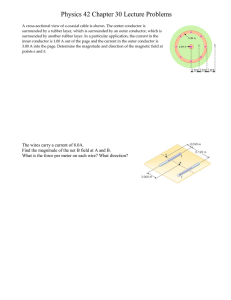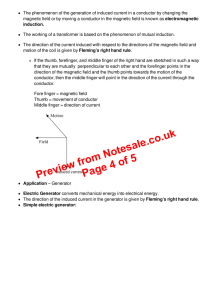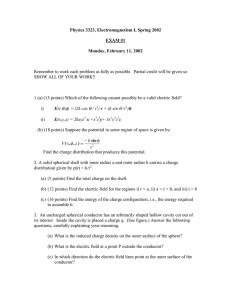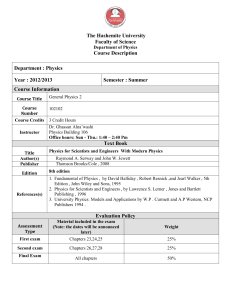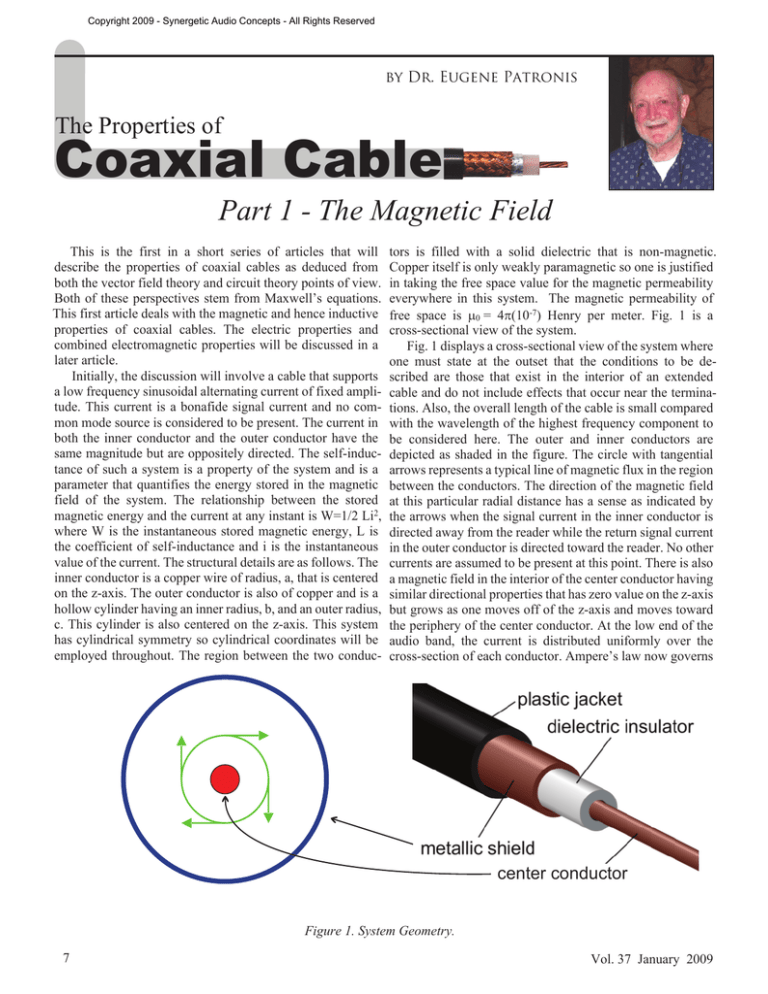
Copyright 2009 - Synergetic Audio Concepts - All Rights Reserved
by Dr. Eugene Patronis
The Properties of
Coaxial Cable
Part 1 - The Magnetic Field
This is the first in a short series of articles that will
describe the properties of coaxial cables as deduced from
both the vector field theory and circuit theory points of view.
Both of these perspectives stem from Maxwell’s equations.
This first article deals with the magnetic and hence inductive
properties of coaxial cables. The electric properties and
combined electromagnetic properties will be discussed in a
later article.
Initially, the discussion will involve a cable that supports
a low frequency sinusoidal alternating current of fixed amplitude. This current is a bonafide signal current and no common mode source is considered to be present. The current in
both the inner conductor and the outer conductor have the
same magnitude but are oppositely directed. The self-inductance of such a system is a property of the system and is a
parameter that quantifies the energy stored in the magnetic
field of the system. The relationship between the stored
magnetic energy and the current at any instant is W=1/2 Li2,
where W is the instantaneous stored magnetic energy, L is
the coefficient of self-inductance and i is the instantaneous
value of the current. The structural details are as follows. The
inner conductor is a copper wire of radius, a, that is centered
on the z-axis. The outer conductor is also of copper and is a
hollow cylinder having an inner radius, b, and an outer radius,
c. This cylinder is also centered on the z-axis. This system
has cylindrical symmetry so cylindrical coordinates will be
employed throughout. The region between the two conduc-
tors is filled with a solid dielectric that is non-magnetic.
Copper itself is only weakly paramagnetic so one is justified
in taking the free space value for the magnetic permeability
everywhere in this system. The magnetic permeability of
free space is m0 = 4p(10-7) Henry per meter. Fig. 1 is a
cross-sectional view of the system.
Fig. 1 displays a cross-sectional view of the system where
one must state at the outset that the conditions to be described are those that exist in the interior of an extended
cable and do not include effects that occur near the terminations. Also, the overall length of the cable is small compared
with the wavelength of the highest frequency component to
be considered here. The outer and inner conductors are
depicted as shaded in the figure. The circle with tangential
arrows represents a typical line of magnetic flux in the region
between the conductors. The direction of the magnetic field
at this particular radial distance has a sense as indicated by
the arrows when the signal current in the inner conductor is
directed away from the reader while the return signal current
in the outer conductor is directed toward the reader. No other
currents are assumed to be present at this point. There is also
a magnetic field in the interior of the center conductor having
similar directional properties that has zero value on the z-axis
but grows as one moves off of the z-axis and moves toward
the periphery of the center conductor. At the low end of the
audio band, the current is distributed uniformly over the
cross-section of each conductor. Ampere’s law now governs
center conductor
Figure 1. System Geometry.
7
Vol. 37 January 2009
Copyright 2009 - Synergetic Audio Concepts - All Rights Reserved
r
the calculation of the magnetic induction
r B everywhere for
all radial distances from the z-axis. B is a vector quantity
whose directional properties have just been indicated. The
magnitude of this vector will be written as B. For the cylindrical symmetry of the present case, Ampere’s law tells one that
at all points on a circle of radius r centered on the z-axis the
magnitude of the magnetic induction is a constant and that
(B)(2pr) is equal to m0 multiplied by the total current directed
through the circle. If the radius of the circle is less than that
of the center conductor then the fraction of the total current
will be (i)(pr2 / pa2) and the magnetic induction will have a
magnitude given by
B=
m 0ir
2pa 2
In this equation, i is the instantaneous current, r is the
radial distance from the z-axis, and, a, is the radius of the
center conductor. This equation applies over the interval 0 ≤
r ≤ a. It should be apparent that in this region B grows
linearly as r increases up to the point where r is equal to a,
where B reaches its maximum value
B=
m 0i
2pa
It is important to note that the magnetic field anywhere in
the center conductor depends only on the current existing in
the center conductor alone. Now consider a circle whose
radius exceeds a, but is less than b. Now the region between
the conductors is under examination. For this circle, the total
current in the center conductor passes through hence
B=
m 0i
2pr
This expression is valid for the interval a ≤ r ≤ b. Again,
the magnetic field in this region depends only on the current
in the center conductor. It should be apparent now that the
magnitude of B varies inversely with respect to the radial
distance in this region until one reaches the inner radius of
the outer conductor at which point B has the value
B=
m 0i
2pb
Finally, let the radius of the circle exceed b such that it is
located in the interior of the outer conductor. The net current
piercing the plane of the circle now is the total current of the
center conductor less the fraction of the oppositely directed
current of the outer conductor. This net current value is given
by
m 0i é c 2 - r 2 ù
B=
ê
ú
2pr ë c 2 - b 2 û
This expression is valid for b ≤ r ≤ c. Note however when
r = c, at the outer surface of the outer conductor, the value of
B has become zero. For all radial distances larger than c, B
remains at zero as the net current passing through a circle of
such radius is zero and thus there is no external magnetic
field. How does this situation change with frequency? As the
frequency is increased the skin effect will come into play
such that the current distribution within the conductors will
no longer be uniform and the fields interior to each conductor
will be modified whereas the magnetic field in the region
between the conductors will be unchanged. The exact frequency at which this becomes important depends on the
cable dimensions, but is typically between 104 and 105 Hz.
At frequencies well beyond the audio band all of the current
supported by the center conductor will be restricted to a
narrow region near the outer surface of this conductor. A
similar statement will be true of the outer conductor except
that the narrow region will be restricted to the inner surface
of this conductor. The mechanisms that produce these distributions are the eddy currents induced in the conductors by
the rapidly changing magnetic fields interior to the conductors themselves. The interior magnetic field grows with
radius in the center conductor so the eddy currents reinforce
near the outer surface and cancel at the interior of this
conductor. For the outer conductor, just the opposite is true.
The magnetic field decreases with an increase of radius and
the eddy currents reinforce at the smaller radius and cancel
at the exterior. As the frequency continues to increase these
regions will become increasingly smaller. The upshot is two
fold. There will be practically no magnetic field in the interior of either conductor and the resistance of each conductor
will be greatly larger than the dc resistance and will continue
to increase as the frequency increases.
The fundamental approach to the calculation of the selfinductance of such a system involves first the calculation of
the energy stored in the magnetic field. The magnetic energy
per unit volume or the magnetic energy density is given by
um =
B2
2m 0
In order to calculate the total stored magnetic energy, it is
necessary to integrate the energy density throughout the
entire volume in which the magnetic field exists. The calculation must be carried out in three steps: the inner conductor,
the region between conductors, and the outer conductor. As
the total volume involved hinges on the length, an arbitrary
2
2
éc -r ù
iê 2
length Dz along the z-axis will be considered when construct2ú
ing the differential of volume. The differential of volume is
ëc - b û
An application of Ampere’s law yields an expression for then 2prdrDz. The magnetic energy stored in the center conductor at any instant is then given by
B in this region that in turn is given by
Syn-Aud-Con
Newsletter
8
Copyright 2009 - Synergetic Audio Concepts - All Rights Reserved
a
m 0i 2 Dz
1
i2r 2
Win = ò m 0 2 4 2prdrDz =
2 4p a
16p
0
The inductance in the intermediate region between center
conductor and outer conductor is calculated in the same
fashion except now one employs the magnetic energy stored
in this region. The result is
The calculation for the region between the conductors
m
æbö
proceeds in the same fashion except now one must employ
Lint = 0 log e ç ÷ Dz
the energy density associated with the magnetic field in this
2p
èaø
region. The magnetic energy stored in the intermediate reThis is by far the principal inductance in the system and is the
gion at any instant is given by
one quoted when discussing the radio frequency range.
b
2
2
Many authors refer to this value as being the outer inducm 0i
m 0i
æbö
p
D
=
D
Wint =
2
rdr
z
z
log
e
ç
÷
tance of the center conductor.
8p 2 r 2
4p
èaø
a
Lastly, the same type of calculation applied to the outer
Lastly, the magnetic energy stored in the outer conductor conductor yields
is calculated from
m 0 Dz
æ 4
1 ö
æcö 3
Lout =
c log e ç ÷ - c 4 + c 2 b 2 - b 4 ÷
2
2 ç
2
2
2
2
2
c
4 ø
èbø 4
m 0i éëc - r ùû
2p éëc - b ùû è
ò
Wout = ò
2
2
2
2
2
b 8p é c - b ù r
ë
û
2prdrDz
The evaluation of this integral leads to the result
Wout =
m 0i 2 Dz
æ 4
æcö 3 4 2 2 1 4ö
ç c log e ç ÷ - c + c b - b ÷
4 ø
èbø 4
4p éëc - b ùû è
2
2
2
The total system stored magnetic energy at any instant is
the sum of these three results. The relationship between the
total system self-inductance and this stored energy is
Wtot =
1 2
Li
2
where L is the coefficient of self-inductance and i is the
instantaneous current. Electromagnetic theory itself does not
require the partitioning of this total inductance to various
parts of the system though it is often found convenient to do
so particularly in this system where there is no external
magnetic field associated with the signal current. In determining the individual inductance associated with each of the
three regions one equates the stored magnetic energy in each
region to one-half the respective inductance multiplied by
the current squared as given in the general relation. The
interior inductance of the center conductor at low frequencies is then
Lin =
m0
Dz
8p
The inductance per unit length for this region of course is this
expression divided by Dz. This is appropriately called the
inner inductance of the center conductor. At a frequency for
which there is a fully developed skin effect, skin depth much
smaller than conductor radius, this inductance becomes zero,
as there is no longer an interior magnetic field in the center
conductor.
9
This is the inductance associated with the outer conductor
at low frequencies. This as well as the inner inductance of the
center conductor diminish as the skin effect begins to develop and of course vanish for a fully developed skin effect.
The conclusions to drawn from this calculation with regard to the outer conductor that supports only the oppositely
directed return current are two-fold. Firstly here exists no
magnetic field in the interval b ≥ r ≥ 0 as a result of the return
current. As a result, there can be no voltage induced anywhere in this same interval when the return current changes
with time. At a radius greater than b, the return current in the
outer conductor begins to reduce the strength of the magnetic
field produced by the current in the center conductor such
that by the time the radius c is reached, the magnetic field
becomes zero. Secondly, there is an inductance associated
with the outer conductor.
Now, consider the case where the desired signal source is
not driving the cable in the conventional manner, but some
independently sourced noise current exists in the outer conductor alone and the center conductor is unconnected. This
current will be designated as I. This current is considered to
be time dependent and can change randomly from moment
to moment. For the low frequency components of this noise
current, the current will be uniformly distributed over the
cross-section of the outer conductor. Refer again to Fig. 1
and take the positive direction of the current to be toward the
reader. Again from the cylindrical symmetry of the problem
the magnetic field is most readily determined by applying
Ampere’s law. Upon constructing a circle of radius r centered
on the z­axis, for 0 ≤ r ≤ b, the current passing through this
circle is zero so there is no magnetic field in this region
produced by the noise current in the outer conductor. Now
for b ≤ r ≤ c, the current passing through the circle is
(r
I
(c
)
-b )
2
- b2
2
2
Vol. 37 January 2009
Copyright 2009 - Synergetic Audio Concepts - All Rights Reserved
and the magnetic field in the interior of the outer conductor in the interval 0 ≤ r ≤ b again depends solely on the combined
due solely to this current is then
current in the center conductor. There is indeed common
impedance coupling between the noise and signal from both
2
2
m0 I r - b
the resistance of the center conductor as well as the inducB=
2
2
tance associated with the center conductor. Additionally,
2pr c - b
there is common impedance coupling between the noise and
This magnetic field produces an energy density given by signal from both the resistance and inductance of the outer
conductor. The reactive voltage component of the common
2 ér 2 - b2 ù
impedance coupling on the outer conductor differs from that
m0 I ë
û
on the center conductor because the inductances of the two
2
2
2
8pr ëéc - b ûù
conductors are greatly different. Remember also that the time
changing current in the outer conductor does not induce any
If now the inductance of the outer conductor is calculated
voltage in the interval b ≥ r ≥ 0. This example constitutes
by the previously employed technique it will be found to be
perhaps a worst case of noise pollution of the desired signal
4
4
and is a strong argument for employing only balanced lines
é 4
m 0 Dz
c 3b ù
æcö
b log e ç ÷ - b 2 c 2 + +
in dealing with audio signals.
ê
ú
2
4
4 û
èbø
2p éëc 2 - b 2 ùû ë
For the final example, an insulated, tightly twisted pair of
conductors replaces the center conductor of Fig. 1, and the
This result is larger now because the magnetic field is that outer conductor makes a snug fit with the twisted pair. The
of the noise current in the outer conductor alone. Notice also desirable signal current exists only in the twisted pair with
that now there is an external field. In fact at the outer surface one wire supporting the send signal current while the other
of the outer conductor the magnetic field has a value of
wire supports the return signal current. Additionally, on each
of the members of the twisted pair there exist equal noise
m0 I
currents of I / 2 flowing in the send direction while on the
2pc
outer conductor there exists only the return noise current I.
Also, of course there is no magnetic field for r ≤ b. The This would be the situation existing in an accurately balanced
example, of course, is incomplete, as a return path for the system with a common mode voltage source. As far as the
current must exist somewhere outside of the cable. The noise current is concerned, this geometry parts from cylindriexample can’t be completed exactly without a detailed cal symmetry in only a minor way so the interior field
knowledge of the geometry of the current return path. Cur- produced by the noise current follows that of the coaxial
rent in the return path may indeed produce a magnetic field cable example. The very close proximity of the signal send
in the interior of the cable. One can safely conclude, however, and return currents produces hardly any magnetic field outthat the current existing in the outer conductor will see both side of a circle that just contains both conductors. The maga series resistance and inductance. Incidentally, in this in- netic field outside the containment circle is thus principally
stance the skin effect here will force the current to the outer that of the noise current except for a very weak or vanishing
surface of the outer conductor at high frequencies as the noise current. The differential voltage produced between the
magnetic field in this conductor increases with radial distance. members of the twisted pair as a result of the changing
With the foregoing as a background, it is now possible to magnetic field generated by the noise current is minimized
look at some situations that involve both a desirable signal by the wire position transpositions introduced by the twists.
current as well as common mode current. Denote the desir- It is essential that the twists be geometrically uniform in
able signal current by the letter i, and the common mode order to produce maximum cancellation.
current by the letter I. Both of these symbols represent the
A few final comments are in order. Magnetic fields for
instantaneous values of the respective currents. These cur- straight single conductors or for closed loop circuits are often
rents co-exist on the coaxial cable of Fig. 1. The two currents calculated by means of the Biot-Savart law in which integrai and I are incoherent and thus have random relative phases. tion is performed along the length of the current carrying
As a result they must be summed quadratically rather than conductor. Such integrations can be quite tedious in the
linearly when calculating the energies or average power general case. Ampere’s law is satisfied for those situations as
associated with combined currents. The quadratic sum is
well though it might not be useful by itself to make the
calculation because of geometrical complexities. The governi2 + I2
ing equations for electromagnetic fields are Maxwell’s equaNow both currents exist on the center conductor. Let the tions. These equations may be written in both differential and
positive direction of each current be away from the reader in integral form. The differential form is listed immediately
Fig. 1. Similarly, both currents exist in the outer conductor below where the arrow overbars designate a vector quantity.
and constitute the return current. The geometry and method
of calculation follow that of our original example except now
one must employ the combined current. The magnetic field
(
(
Syn-Aud-Con
Newsletter
)
)
10
Copyright 2009 - Synergetic Audio Concepts - All Rights Reserved
r
r
¶B
ÑxE = ¶t
r
Ñ·D = r
r
r r ¶D
ÑxH = J +
¶t
r
Ñ·B = 0
meter2, and s is the electrical conductivity measured in
Siemen per meter.
The first of Maxwell’s equations is an expression of
Faraday’s law of electromagnetic induction; the second expresses the existence of electric monopoles that is one can
have a quantity of isolated positive or negative charge. The
third is Ampere’s law as amended by Maxwell to include the
displacement current density. The displacement current density is the second term on the right hand side of the third of
Maxwell’s equations. It would be significant in the coaxial
These basic equations are further supported by what are cables that have been discussed previously only at extremely
called the constitutive relations that for linear media are high frequencies and hence has not entered into the example
calculations. The fourth of Maxwell’s equations expresses
stated as the following.
the fact that up until this point in time no one has observed
r
r
D = eE
an isolated magnetic pole or magnetic monopole. The third
r
r
of the constitutive equations is the microscopic statement of
B = mH
Ohm’s law. Now if one writes the third of Maxwell’s equar
r
J = sE
tions in the integral form while neglecting the displacement
current density what appears will be Ampere’s law as it has
In these equations m is the magnetic permeability of the
been applied in all of the previous examples.
medium in question expressed in Henries per meter (in
r r
r r
non-magnetic material or free space this is called m0 ) and e
B · d1 = m 0 J · dS
is the electric permittivity
of the medium (in free space this
r
This is particularly easy to apply in problems possessing
is
called
e
).
is
the
magnetic
induction measured in Tesla,
B
0
r
cylindrical
symmetry because the magnetic field has a fixed
is
the
magnetic
intensity
measured
in
Ampere
per
meter,
H
r
r
E is the electric field strength measured in volt per meter, D magnitude at a fixed radius of the path encircling the current
is the electric displacement measured in Coulomb per meter2, and its direction is tangential to the circle so the line integral
r is the free
r electric charge density measured in Coulomb per on the left becomes simply B2pr and the surface integral on
meter3, J is the current density measured in Ampere per the right is just the net current passing through the circle
multiplied by m0. ep
Ñò
11
ò
Vol. 37 January 2009


